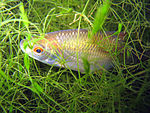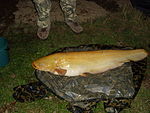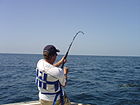Coarse fishing: Difference between revisions
as per WP:MOS |
|||
| Line 1: | Line 1: | ||
'''Coarse fishing''' is a term used in the [[United Kingdom]] and [[Republic of Ireland|Ireland]] for [[Sport fishing|angling]] for ''coarse fish'', which are those types of freshwater fish other than ''[[game fish]]'' ([[trout]], [[salmon]] and [[Salvelinus|char]]). The sport and the techniques used are particularly popular in the United Kingdom and [[mainland Europe]]. |
'''Coarse fishing''' is a term used in the [[United Kingdom]] and [[Republic of Ireland|Ireland]] for [[Sport fishing|angling]] for '''coarse fish''', which are those types of freshwater fish other than ''[[game fish]]'' ([[trout]], [[salmon]] and [[Salvelinus|char]]). The sport and the techniques used are particularly popular in the United Kingdom and [[mainland Europe]]. |
||
==History== |
==History== |
||
Revision as of 09:29, 10 October 2009
Coarse fishing is a term used in the United Kingdom and Ireland for angling for coarse fish, which are those types of freshwater fish other than game fish (trout, salmon and char). The sport and the techniques used are particularly popular in the United Kingdom and mainland Europe.
History
The term "coarse fishing" originated in the United Kingdom in the early 19th century. Prior to that time, recreational fishing was a sport of the gentry, who angled for salmon and trout which they called "game fish". Other fish were disdained as "coarse fish".[1]
Tackle and technique
Depending on the situation, different types of tackle can be used. Most common is the rod and reel, the rod being typically between 10 and 13 feet (4.0 m) long, and manufactured of tubular carbon fibre. A reel is then attached near the base of the rod to hold a long length of line, which is run to the tip of the rod through eyelets. Once cast out, the line can be retrieved by winding a handle on the reel.
However, the use of "poles" is also now widespread. Here, the line is fixed to the very tip of the rod, with no reel used- in order to retrieve the line, the pole itself is taken apart until the line can be swung to hand. Because the line cannot be cast, poles are often very long in order to increase the angler's range- up to 16 metres.
The main techniques used are float fishing, legering and spinning.
- In float fishing, the bait is suspended beneath a float made of hollow plastic, wood or quill. The top of the float is usually painted a bright colour and bites are indicated by the top of the float dipping under the surface of the water.
- Legering does not use floats. Instead the bait is held on the bottom of the lake or river by a sinker or large weight. Bites are detected by watching the quiver tip of the rod for movement, or with the use of electronic bite alarms, and more advanced tackle such as Polyvinyl alcohol bags, or mesh.
- Spinning. Either a brightly coloured lure or a small fish attached to a hook is towed through the water to attract carnivorous fish such as pike, zander and perch.
Fly fishing techniques may also be used for certain species, such as grayling or chub.
For float and leger fishing, groundbait is usually thrown into the water to attract fish to the area. Typical baits include nightcrawlers, maggots, bread and sweet corn. Lately, advancements in technology and market competitiveness has led to many types of other ingredients being introduced, including chemicals, such as betaine, that stimulate the feeding response in fish. Boilies are popular baits for carp fishing.
Types
The nature of coarse fishing varies with the dedication and attitude of the angler:
- Pleasure angling: Anglers go out to enjoy a relaxing day's fishing, trying to catch anything that comes by without putting too much effort in, with anything caught being a bonus.
- Match angling: Anglers, in angling clubs or as individual entrants, gather together at a venue to catch as many fish as possible in an allotted period of time. Contests are held at local, regional, national and international levels.
- Specimen hunting: The aim with this type of coarse fishing is to specifically target a chosen species of fish, in order to weigh and photograph it when you catch a personal best. The main target species for this branch of coarse fishing include carp, pike, zander, barbel, chub, perch and Wels catfish. Some dedicated specimen anglers spend weeks camping by the waterside waiting for that "fish of a lifetime".
Target species
The main target species for this type of angling include:
| Name | Image | Varients |
|---|---|---|
| Barbel | 
| |
| Bream | 
| |
| Carp |  |
Grass, Common, Crucian, Leather, Mirror |
| Chub | 
| |
| Dace | 
| |
| Ide | 
| |
| Perch | 
| |
| Pike | 
| |
| Roach | 
| |
| Rudd | 
| |
| Tench | 
| |
| Wels catfish | 
| |
| Zander | 
|
There are also some lesser species that can be caught in the United Kingdom and are not normally sought after. These include:
Notes
- ^ Lowerson
References
- Cooper, Dave (2004) First Class Fishing Fishing Magic.
- Lowerson, John (1993) Sport and the English middle classes, 1870-1914. Manchester University Press. ISBN 0719037778
- Tranter, Neil (1998) Sport, Economy and Society in Britain 1750-1914. Page 101. Cambridge University Press. ISBN 052157217
Further reading
- Bailey, John (2008) Where to Coarse Fish in Britain and Ireland. New Holland Publishers Ltd. ISBN 978-1845379346
- Partner, Steve (2007) Coarse Fishing Basics. ISBN 978-0753715864
External links
- Coarse fishing at Curlie
- Coarse fishing: The sport of gentlemen
- Fishing for fun
- Henfold Lakes: Coarse Fishery Pictures from Surrey, England
- Anglers net: Coarse fishing articles
- Coarse fishing venues on google maps. Angling Social Networking




